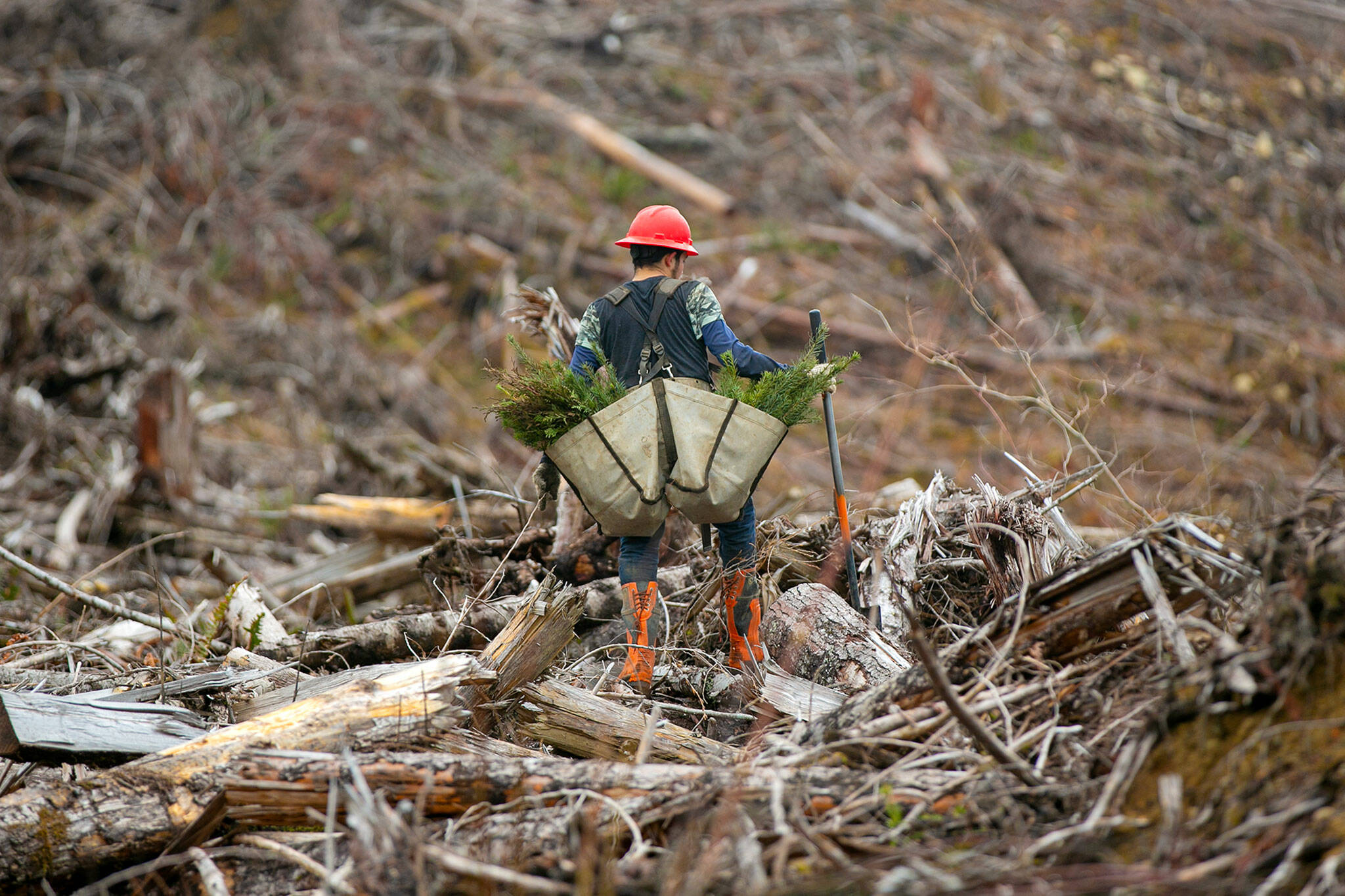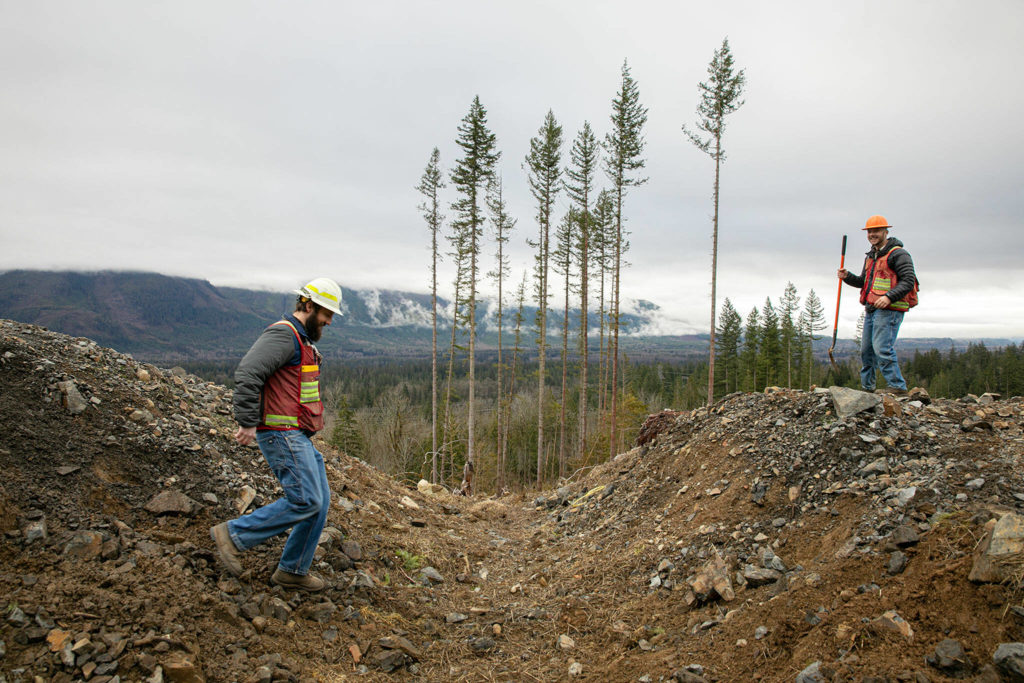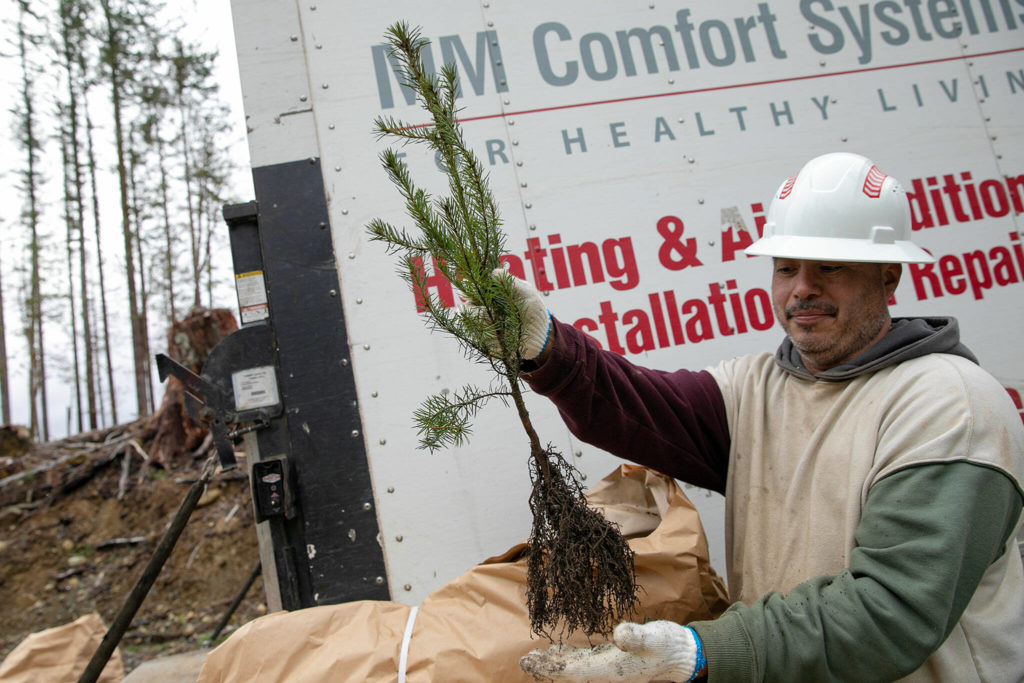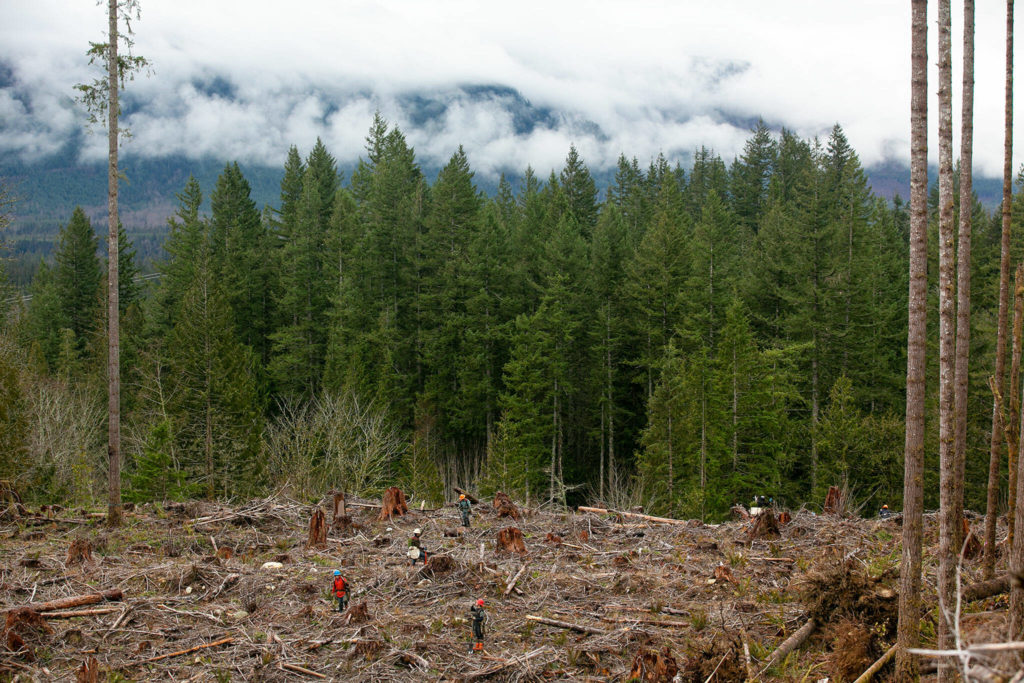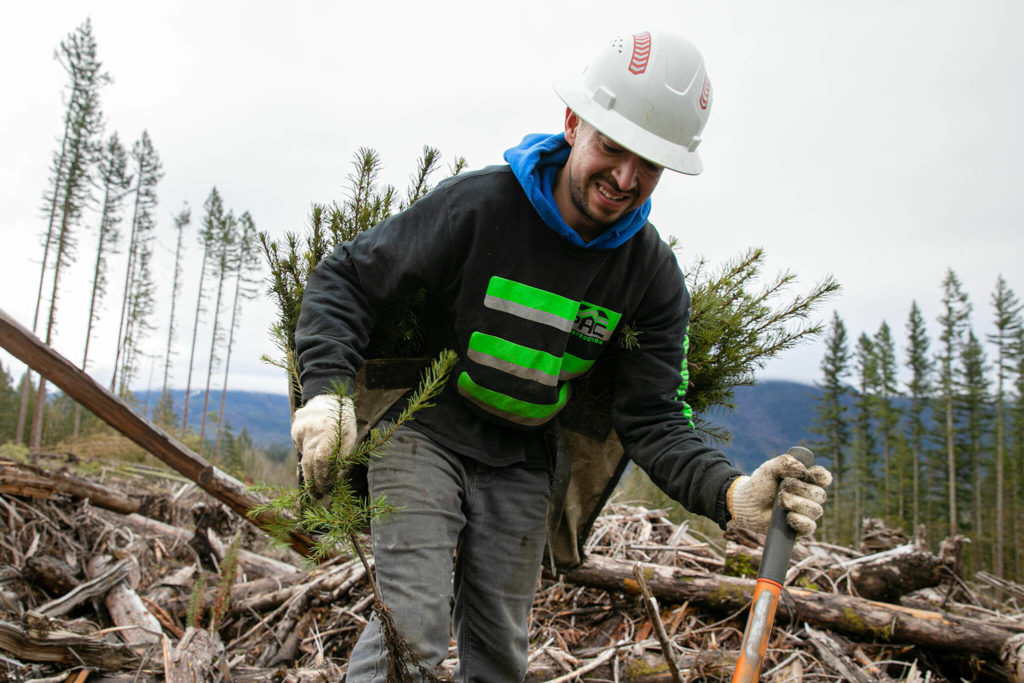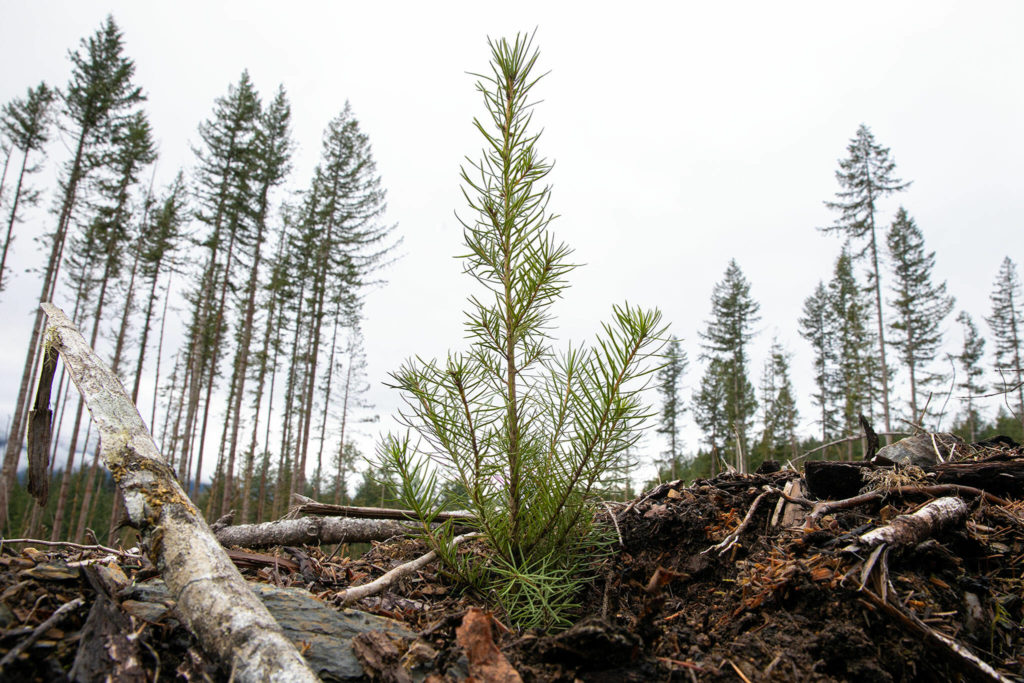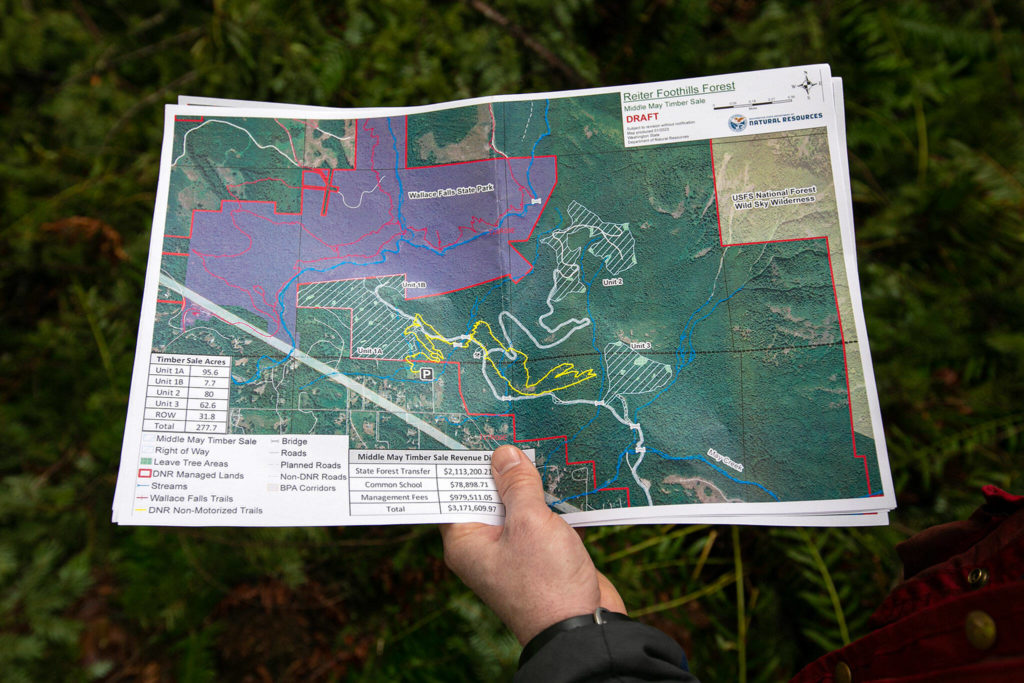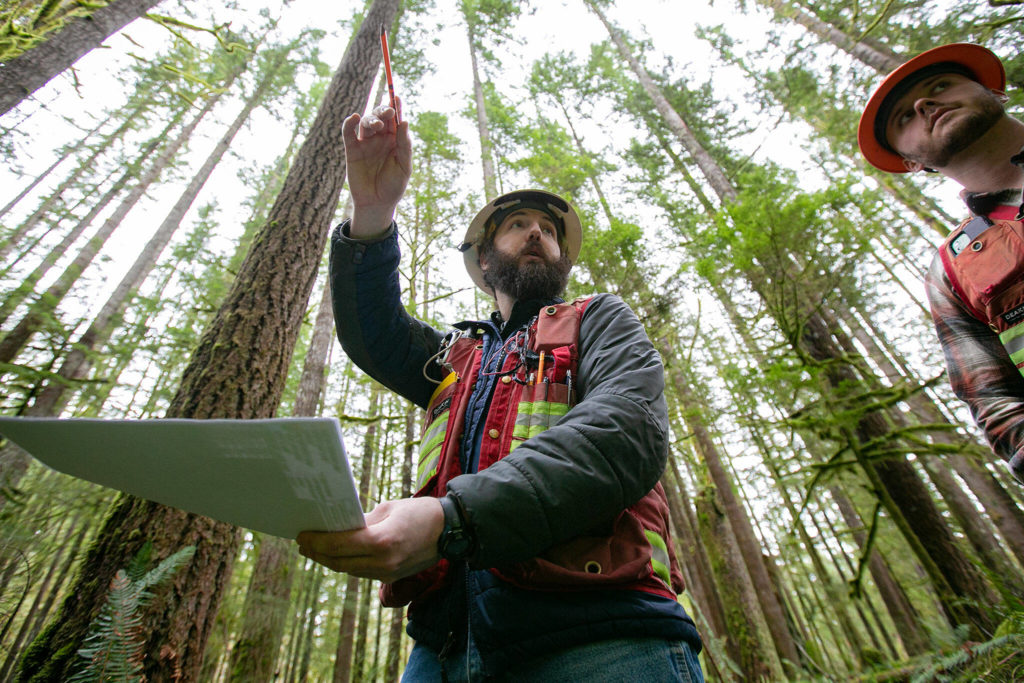GOLD BAR — The workers make the trip up and down the steep, stump-riddled hillside dozens of times a day. From a clearing of freshly tilled soil, dotted here and there with clusters of 100-foot-tall trees, they scramble up the loose slope, canvas bags on their backs.
Hundreds of seedlings, miniature Douglas firs and Western red cedars, are freed from the brown paper bundles in which they arrived from the state nursery in Tumwater, then stuffed into the workers’ sacks. They crack open plastic bottles of water, knock back nearly the whole thing in one go, then clamber back down the hill, now 50 pounds heavier. It’s tedious, backbreaking work, but these guys are pros — in a week or two, the crew of 14 will have planted 26,000 new trees in the clearing.
The clearing, now known as Unit 1A of the Middle May timber sale, was once 72 acres of dense fir and hemlock in the Reiter Foothills, about 2 miles northeast of Gold Bar. The huddled groups of trees towering over the empty land are all that’s left of this chunk of forest, left behind to preserve wildlife habitat while the seedlings play catch up.
The Middle May site has been the center of controversy for over a decade. Local residents protested what they said amounted to a clearcut of valuable natural resources, long treasured by hikers and off-roaders. The state Department of Natural Resources, which manages the land, said the sale would bring in funds for schools and hospitals without compromising the forest’s value for future generations.
After several false starts, Sierra Pacific Industries bought the timber at auction for $3.17 million in 2020. With the timber harvest now complete and restoration efforts underway, forest managers say Middle May has a lot of life left in it. But those opposed to the sale still think it should have been done differently.
DNR spokesperson Kenny Ocker said Middle May is State Transfer Fund trust land, once privately owned parcels forfeited to the state in the 1920s and ’30s due to unpaid property taxes. DNR now manages these lands on the state’s behalf, and the profits from their harvests benefit the counties where they’re located.
DNR retained about 25% of the sale to cover staff time, maintenance and other operations, Ocker said. The majority of the profits from this harvest, about 72%, went back into trust, earmarked for the Sultan School District, Sno-Isle Libraries and Valley General Hospital in Monroe, among others. Ocker said if managed correctly, this forest will create income for those entities for decades to come.
Unit 1A is one of four sale units, totaling 160 acres, spread around the western Reiter Foothills. DNR estimates the sale yielded about 9 million board feet of lumber. That’s equivalent to about 5,800 cords of firewood, or enough to heat nearly 2,000 homes through a Western Washington winter.
But before a single chainsaw was put to a trunk, the buyers had to build from scratch the infrastructure — 6 miles of gravel road and five bridges — needed to get heavy equipment up the slopes. Some spurs of the road have already been abandoned to natural regrowth, their useful lives over. The rest will be used for maintenance and future projects.
It’s not the first time this forest was harvested, but it’s far more efficient this time around. In the early 20th century, lumber was hauled off by trains chugging up the craggy hillside, unit forester John Moon said. While his team was surveying the sale area pre-harvest, they found abandoned railroad grades and chunks of rusted metal still littering the landscape.
‘We’ve invested in them’
The clumps of trees left standing in the otherwise empty clearing are the eight per acre the buyers were obligated to leave as part of the variable retention method used in the harvest, Moon said. Before crews started felling trees, DNR staff marked the “leave trees” with bright orange stripes. Some protect squirrel middens and bird nests, others stabilize rocky slopes. They’ll help reseed the clearing along with the new blood the planters are introducing.
DNR silviculture manager Cody Toppingsaid the process by which the department replaces harvested trees closely mimics the natural process forests undergo after a natural disaster, like a fire or widespread disease. Over the next several decades, a new generation of occupants would take over the cleared land: first low-lying, hardy stragglers like alder and cottonwood, then the stately conifers, fir and cedar and hemlock. A century later, that new forest would likely suffer its own downfall, and the process would begin again.
In this case, Topping said, forest managers are just speeding up that process by a few decades and skipping the shrubbery, kicking off with the conifers. After this summer, teams will revisit the site and make sure most of the seedlings survived their infancy, culling those that didn’t and replacing them with new starts.
“After about year five, you’re kind of looking at your garden,” Topping said. “How many weeds do you need to pull? Are your crops packed too tightly together? We want to keep an eye on these trees, because we’ve invested in them well into the future.”
A half-mile-long swath of mature forest, extending from the Snohomish County-managed trailhead on 429th Avenue NW in Gold Bar to the southern boundary of the state park, was left in place to preserve recreation and to protect habitat for the endangered northern spotted owl.
A short stroll down the trail from the gravel road, you’d hardly know any harvesting had happened here at all: a nameless branch of May Creek babbles loudly nearby, a breeze ruffles the topmost pine needles.
About half a mile of Reiter’s 4-mile loop trail was rerouted by the harvest, and DNR crews were working to replace signage and clear fallen trees from the path.
The trail will hopefully one day be connected with the network in Wallace Falls State Park, directly to the north of Middle May’s Unit 1, Moon said. Reiter’s non-motorized trails have been closed since 2020 while harvesting was ongoing, but Moon said hikers can expect the loop to get a “soft opening” within the coming weeks. The eastern half of the forest’s trails, earmarked for motorized recreation like off-roading and dirt biking, weren’t disturbed by the project.
Moon said these two points were priorities among those who turned out to the agency’s numerous “community conversations” in the years since a county judge voided the site’s original sale in 2017. Forest managers went back to the drawing board after that, he said, trying to strike a balance between turning a profit on the sale and preserving the forest for recreation and habitat.
Foresters chose the sale units very carefully, accounting for countless “moving parts,” Moon said. Those included leaving room for wildlife habitat, stream buffers and unstable slopes, while controlling for timber quality. He estimated most of the trees harvested were between 60 and 80 years old, members of the generation that reseeded the foothills after clearcutting and forest fires in the early 20th century.
‘We lost this one’
Parts of the Middle May sale are near ideal growing habitat, Moon said, and the trees bounced back relatively quickly from those earlier harvests and fires. It’s hard to tell from looking at the dense, moss-draped forest surrounding the cleared units that the landscape was likely completely different only a century ago, that ancient mine shafts are still open if you know where to look.
But the activists who opposed the Middle May sale for years say they think DNR wasn’t careful enough, and they’re worried the results will leave scars on the landscape for decades to come.
Peter Goldman, a lawyer with the nonprofit Washington Forest Law Center, represented local group Sky Valley Future in opposing DNR’s plans for Reiter. He said he and the group don’t oppose logging in principle, but they felt from the start that the agency wasn’t doing all they could to protect a treasured local resource.
Goldman’s group hired outside forestry experts to develop an alternative harvest plan they said would be less intensive than the variable retention method DNR ended up using. By his estimation, the alternate plan would have saved a lot of damage to the forest while still making up to 60% of Middle May’s ultimate profits. But he said the agency didn’t show much interest when they presented it, and the harvest went ahead as planned.
“At a certain point, we had to throw our hands up and recognize we lost this one,” Goldman said.
A key concern among local activists was that DNR’s analysis of the site didn’t take into account the impacts easterly winds could have on the denuded forest. Mike Town, an ecologist and retired teacher who’s lived in the Sky Valley for years, said locals know that east winds don’t happen too often, but when they do, they tend to cause a lot of damage.
Town said DNR’s State Environmental Policy Act checklist, used to gauge the potential risks and outcomes of a harvest, didn’t take those east winds into account at all. When they brought their concerns to the agency, they got an official response suggesting the winds weren’t anything to worry about.
When Town and other locals visited the site after an intense December windstorm, he said they found dozens of trees knocked over. He said many of the designated leave trees, exposed to the winds after the surrounding forest was cut, had blown over. The same thing happened on the site’s boundary with Wallace Falls State Park, Town and Goldman said, damaging trees within the park.
Town said that’s a well documented side effect of clearcutting, known as the edge effect. It’s something the group’s alternative plan tried to account for, with Goldman suggesting a 100-foot buffer of trees left between the sale site and the state park could have mitigated a lot of the wind damage. The damage that’s already been done, he worries, will mean more trees will meet the same fate until the replanted site is fully reforested, which could take decades. With more sales in the works, the group fears the forest will continue to suffer unless DNR changes its methods.
Two more sale sites, this time on the motorized side of Reiter, are already in the process of road construction, Ocker said. Two more are in the “conceptual” stage, planned for sale in 2024 and 2025. Ocker said DNR continues to meet with local stakeholders regularly to get feedback on future plans, incorporating their input into leave tree selection, trail management and other parts of the plan. Many of these strategies were developed from the contentious process of planning Middle May, he said.
On private land, the Reiter sites might have been harvested years earlier. But Moon said it’s generally department policy to let a forest go at least 60 years between harvests. The extra time, besides more closely mirroring natural forest succession, ensures DNR gets the best return on its investment because the trees have had time to produce more and better-quality timber.
Chances are Middle May itself will be harvested again. Two or three decades from now, Moon said, the department will check in on the new forest to see if it can support a thinning. Rather than a total harvest, the buyer would strategically cut about a third of the trees in the unit. Fifty years out, they might start planning a large-scale sale again.
Thoughts of the future are a common refrain among the forest managers as they hike back to their vehicles, scrambling effortlessly down the slopes of gravel ditches left to channel rainwater across the abandoned forest road. The loggers who felled Middle May a hundred years ago didn’t take any measures to protect the nearby Wallace River or to consider the place’s Indigenous heritage, Moon said.
But before the forest was cut this time, countless hours went into envisioning how it would look decades from now, Ocker said. Because Middle May is trust land, it has to be managed to continue producing revenue for its beneficiaries in perpetuity.
“We have an obligation that we can’t manage for one generation above others, we have to manage intergenerationally,” Ocker said. “If it weren’t a perpetual trust, we would just put everything up for sale next year. But we have to do this sustainably in time across multiple generations.”
But forest policy changes all the time according to environmental needs, department quotas and more, and Moon said it’s impossible to guess what the foresters of a half-century from now will choose to do with Middle May.
“We’ll see what new rules there are, what existing rules go away, and we’ll evaluate what timber is here 40 or 50 years from now,” Moon said. “And somebody other than me will make a decision about what to do with the stand. At least I hope I won’t be out here — my knees won’t take it.”
Riley Haun: 425-339-3192; riley.haun@heraldnet.com; Twitter: @RHaunID.
Talk to us
> Give us your news tips.
> Send us a letter to the editor.
> More Herald contact information.
